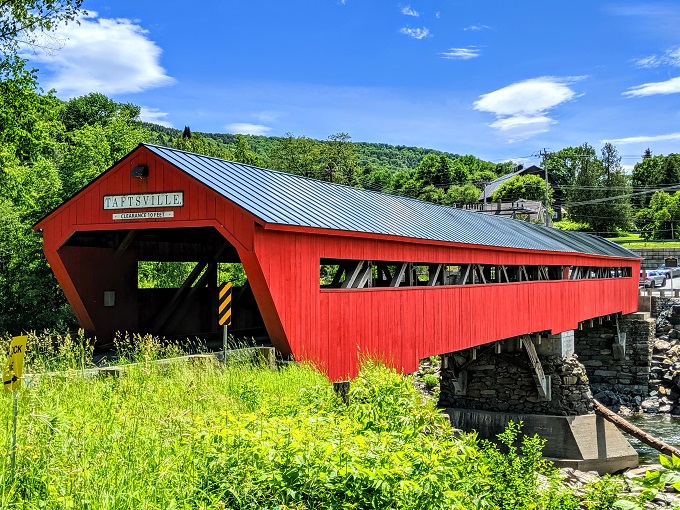Vermont boasts some impressive statistics when it comes to covered bridges: There are more than 100 in the state, which ranks it No. 1 in the nation in covered bridges per square mile. One of these spans is the longest wooden bridge in the country. Ninety of the state’s covered bridges have been listed in the National Register of Historic Places, according to the state. Every Vermont county except one has a covered bridge, and one Vermont town lays claim to more covered bridges than any other town in the United States.

With more than 100 bridges — many more than a century old — there are countless stories to tell about them. Many predate motor vehicles, many have suffered damaging floods, some are said to be haunted. Covered bridge enthusiasts have documented many of these physical and lyrical histories in books dedicated to Vermont and New England’s covered bridges. The Vermont Covered Bridge Society formed in 2000 in an effort to actively preserve the state’s remaining covered bridges — and along the way has created a fellowship of fans and an online depository for bridge news and stories.
But why, when it clearly takes more effort and expense, cover a bridge anyway? The very reason for covered bridges is why centenarian river crossings remain standing. The roof and sides, which can more easily be replaced and repaired, protect the main structure that carries the weight. In his book “Spanning Time: Vermont’s Covered Bridges,” Joseph C. Nelson argues that a well-made wooden bridge protected from moisture can be superior to concrete and steel because wood is impervious to salt damage. A side benefit was that the walls protected horses and livestock from being spooked while crossing turbulent waters. (They may also shield the antics of bored kids and lovers stealing kisses.)
Nelson and other covered bridge enthusiasts urge visitors to do more than take a quick picture while passing through. Covered bridges hold within tangible glimpses into history. The bridge truss types, tool marks left on beams, bridge location — even the density of wood grain — tell more about the bridge and the context in which it was built.
With so many stories to explore, where to start?
Let’s start with the biggest bridge. In fact, the Cornish-Windsor Bridge, which spans the Connecticut River between Cornish, N.H. and Windsor, Vt., is the longest wooden covered bridge in the United States. And, according to the state of New Hampshire which owns the bridge, it is the longest two-span covered bridge in the world.
The Cornish-Windsor Bridge was built in 1866 and is officially listed as 449 feet and five inches long (though some accounts say it is 460 feet). Perhaps even more impressive is that it is still in regular use today. In January it underwent significant work to replace worn deck planks, an essential fix for a bridge that still carries about 2,700 cars daily.
The structure originally cost $9,000 to build, according to the state of New Hampshire, which purchased the span in 1936 and operated it as a toll bridge until 1943. The bridge suffered damage from flood and ice in 1977 and a decade later it was closed entirely for reconstruction that cost about $4.5 million. It reopened in 1989.
The bridge is listed on the National Registry of Historic Places and as an American National Historic Civil Engineering Landmark by the Society of Civil Engineers.
Prior to the covered bridge built in 1866 the site was home to three bridges that were all damaged by floods. The first was built in 1796, the next two 1824 and 1850. The last was destroyed by water and ice in March of 1866.
Yet, at nearly 150 years old, the Cornish-Windsor Bridge survived Tropical Storm Irene in 2011, which damaged or swept away other covered bridges in Vermont and elsewhere in the Northeast.
A Bridge Reborn
One of those that did not survive that historic deluge was the Bartonsville Covered Bridge. Video shot by resident Susan Hammond during the storm aired on the national news and people around the world saw footage of the bridge sinking down into the water and being swept, almost whole, down the Williams River.
The original Bartonsville Covered Bridge was built in 1870 and stood at 159 feet long, one of the longest in Vermont according to “Covered Bridges of Vermont” by Ed Barna. It was built after another historic flood back in 1869 changed the course of the Williams River, according to a website dedicated to the efforts to rebuild the bridge in 2011.
The bridge was rebuilt, and the new Bartonsville Covered Bridge opened in January 2013. Hammond, whose heartbreak can be heard in the viral video, led a fundraising effort to help rebuild the bridge. Hammond’s father was the first to cross the newly built bridge at the opening day ceremony, according to a news article from the day.
See For Yourself
There is no better time than autumn to enjoy the beauty and history of Vermont’s covered bridges. Many are clustered close enough together to make it easy to see a handful in one drive.
Perhaps the best place to start is the state’s “covered bridge capital,” Montgomery. The small northern Vermont town champions its bridges. “Our unique geography required many bridges, and as recently as the 1940s there were 13 covered bridges within the town’s limits. Today there are six covered bridges within town limits, and one which straddles the town line with Enosburg — the most of any town in the country,” the municipal website proudly states.
The town of Northfield is not far behind with five public covered bridges. Three are in close proximity on Cox Brook Road. The town is only about 10 miles south of Montpelier, making a visit to the historic state capital an easy addition.
Woodstock is as quaint and iconic as a Vermont town could get and is a popular destination in all seasons. Four covered bridges are nearby: the Lincoln Covered Bridge on Route 4 near the Lincoln Inn and Restaurant in West Woodstock; Middle Bridge on Mountain Avenue near the intersection with North Park Street in Woodstock; and the Taftsville bridge near the intersection of Vermont 12 south and U.S. 4.
For more information about Vermont’s covered bridges check out these resources:
Vermont Covered Bridge Society: Vermontbridges.org
Vermont Department of Tourism Covered Bridge Website
*Note the Vermont Covered Bridge Museum mentioned in the video on this site is now closed
Town of Montgomery website, including information about its covered bridges: Montgomeryvt.us
Books
Spanning Time: Vermont’s Covered Bridges by Joseph C. Nelson
Covered Bridges of Vermont by Ed Barna
Clover Whitham has been a journalist at Vermont newspapers for more than a dozen years and is now a freelance writer and editor near Burlington.
Related Articles & Free Vermont Maturity Subscription

Skiing in Vermont: Big Ideas and Quirky Characters
The Vermont Republic – The Story of When Vermont was an Independent Country






Comment here